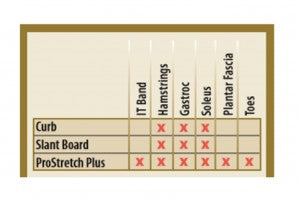FREE SHIPPING ON ORDERS OVER $25*
FREE SHIPPING ON ORDERS OVER $25*

ProStretch Plus preferred world-wide for tight calves and hamstring stretching.
Tight calves can cause trouble for any active individual. Stretching tight calves and keeping both the calf and the entire posterior chain (the series of lower body muscles including lower back, glutes, hamstrings, and calves) strong and flexible are an important part of any conditioning and injury prevention strategy. This series of muscles works in a chain-like manner. Imbalances in flexibility and strength along this chain can often result in knee, lower back or Achilles tendon injuries. This is especially important with active adults and youth athletes.
“These boys’ hamstrings are so tight. They’re growing so fast that their muscles can’t keep up. Keeping their hamstrings and calves flexible is critical to preventing injuries especially to the back and knees and for preventing plantar fasciitis and Sever’s,” says Delano Carneiro, High School Lacrosse Strength & Conditioning Coach and trainer.
Carneiro is always looking for stretches that give his athletes the “biggest bang for the buck”. For tight calves and the posterior chain he, like most coaches, has relied on students’ independent/manual stretching. But not all stretches are created equal.
Safety, control, compliance, effectiveness, and efficiency need to be taken into consideration when designing a stretching protocol. It’s easy to ineffectively perform stretches with poor technique, lack of effort or inadequate time.
Maria Hutsick, Athletic Trainer, Medfield High School and former Director of Sports Medicine at Boston University was pleased with the options that the ProStretch Plus provided,
“Many of our runners preferred using the ProStretch Plus. They appreciated the deeper hamstring and calf stretch it provided and their ability to control how they worked into the stretch.” Hutsick also used the ProStretch Plus as an educational tool, “The ProStretch Plus enables the user to stretch the plantar fascia and to isolate the hamstrings, gastrocnemius, and soleus. It provides a great way to teach the difference between the muscles and how to stretch each thoroughly.”
She noted that some of the male athletes preferred the slant board for the passive nature of the stretch and the ability to stretch both legs at once. Carniero recently used the ProStretch Plus with his athletes. “The ProStretch Plus is a versatile tool,” notes Caniero. “I love having it on the sidelines.
Players get a much better hamstring and calf stretch than they do with the manual exercises. More importantly they want to use it so I know they’re getting their stretching done effectively.” Carniero finds curb stretching comparatively inconvenient and limiting. “I work with male and female athletes.
The curb doesn’t allow those with tight calf muscles to ease into their stretch and requires a lot of repositioning. Some of the manual calf and hamstring stretches just aren’t deep enough for the more flexible athletes.
The ProStretch Plus accommodated everyone.” Carniero noted that he personally suffers from tight plantar fascia and says the toe lift provides a great stretch. Evaluating Stretching Options

Even at the highest levels it can be hard to get athletes to take stretching as seriously as strength training. Identifying stretches that are effective, efficient and engaging goes a long way towards fostering compliance and achieving results.
ProStretch Plus: Allows for targeted stretching of all of the major components along the posterior chain including IT band, hamstrings, gastroc, soleus, plantar fascia and toes. The unique design automatically holds the foot in the optimal position for providing a biomechanically accurate and safe stretch. The rocker allows the athlete to ease into and control the stretch at their own pace and encourages a longer, deeper stretch. ProStretch provides a full range of stretching from 8 – 43 degrees. The movable foot rest delivers both foot size and stretching degree options. The optional toe rest provides a maximum stretch of the plantar fascia and toes.
Slant Board: While many slant boards can be adjusted, the options are preset and the change is a manual, disruptive process requiring the user to stop the stretch and reposition. Primary muscles targeted: calves and hamstrings.
Curb: Like the slant board the curb forces the calf into a fixed position. If the stretch is too deep or not deep enough repositioning is required. This often leads to under or over stretching.
Manual Stretching: Manual stretches will work for some better than others and in some cases will not provide a deep or complete enough stretch. A comprehensive routine of individual stretches may prove to be inefficient and difficult to ensure compliance.
For over 20 years trainers, athletes and physical therapists have relied on ProStretch® to safely and effectively stretch tight calves, hamstrings and the posterior chain.
ProStretch Plus®, which accommodates both a wider range of foot sizes and adds a plantar fascia and toe stretch is quickly becoming the new favorite.
The post Tight Calves Stretches: Not All Stretches Are Created Equal appeared first on Medi-Dyne.


